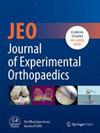Anatomical landmarks are more accurate in identifying the ideal femoral insertion for modified Larson reconstruction of posterolateral corner than radiological landmarks
Abstract
Purpose
In surgery for posterolateral knee instabilities, the modified Larson technique (MLT) is a fibular tunnel–based reconstruction technique with a single femoral tunnel aiming for an isometric graft insertion point (IGIP). The IGIP can be located intraoperatively using an anatomically referenced method (ARM) or a radiological method (RM). The purpose of this experimental study was to compare the ARM with the RM in terms of isometric behaviour and to report the location of the ARM and RM in relation to the lateral epicondyle (LE).
Methods
Flexion/extension movement of eight fresh-frozen human knee joints was simulated in a custom-made knee test bench. A fibular tunnel was created as described in the MLT, and a suture was shuttled from the IGIP through the tunnel and connected to a displacement transducer. The isometry of the IGIP of the ARM and RM was evaluated on the basis of suture displacement during flexion/extension motion. The position of the determined IGIP relative to the centre of the LE was measured on true lateral X-rays.
Results
Comparison of the isometry behaviour of the two techniques showed that RM resulted in a displacement of 10.46 ± 3.69 mm, whereas the ARM showed a of 6.09 ± 2.11 mm during flexion/extension motion (p = 0.017). The median location of the ARM and RM was 6.5 mm (IQR 8.375 mm), 5.45 mm (IQR 3.5 mm) distal and 3.95 mm (IQR 6.9 mm), 4.55 mm (IQR 5.75 mm) anterior to the centre of the LE, respectively.
Conclusions
In the present in vitro experiment, the ARM was capable of determining the femoral IGIP more accurately than the radiological method. For clinical practice, it is recommended to start approximately 6.5 mm distal and 3.95 mm anterior to the centre of the LE in order to determine the IGIP when performing MLT.

 求助内容:
求助内容: 应助结果提醒方式:
应助结果提醒方式:


